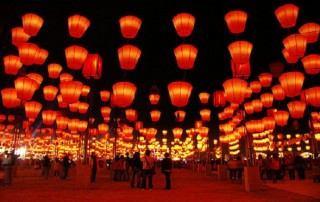The Lantern Festival (Yuán Xiāo Jié - 元宵节) occurs on the 15th day of the first month in the lunisolar calendar and marks the end of the Chinese New Year celebrations. Like all the Chinese holidays, the Lantern Festival is wrapped in myths and legends!
Yuan Xiao
Why is this festival called Yuan Xiao Festival? Very simple, although two-sided! The first month of the lunisolar calendar is called yuan and in ancient times, people called night xiao. The first full moon of the new lunisolar year can be seen during the night of the 15th day of the first month. To celebrate and show appreciation for the fact that nature and higher beings had brought back light to earth each year, people hang out thousands of colorful lanterns. And so the Lantern Festival was born! For the other explanation for the name of the festival, we have to dive into the kitchen! Since people all over China eat rice dumplings (tāngyuán – 汤圆 or yuánxiao - 元宵) on the fifteenth day of the new year together with their family and hang red lanterns on their houses, that day is called Yuan Xiao Festival.
Shedding light on the origin of the Lantern Festival
 The origin legends of the Lantern Festival are numerous! Of course no surprise here, since we are talking about the origin of a Chinese holiday. One of them tells the story about a beautiful yellow crane, being treasured by the Jade Emperor. One day the crane flew down to earth from heaven. When it landed on earth, unfortunately, it was hunted down and cruelly killed by the villagers. The Jade Emperor, being furious and devastated about the murder of his favorite crane, swore to send a disastrous storm of fire to the village on the fifteenth day of the new lunisolar year. The Jade Emperor’s daughter felt sorry for the poor villagers and warned them about her father’s plan. The inhabitants felt lost and were overwhelmed with great panic! Until a wise man suggested that every family should hang red lanterns on their houses, set up bonfires on the street and explode firecrackers on the fifteenth day. That way, the Jade Emperor, thinking that the village was already on fire, would cancel his plan….and it worked! To celebrate this, people would from then on hang red lanterns on their houses on the fifteenth day of every new year.
The origin legends of the Lantern Festival are numerous! Of course no surprise here, since we are talking about the origin of a Chinese holiday. One of them tells the story about a beautiful yellow crane, being treasured by the Jade Emperor. One day the crane flew down to earth from heaven. When it landed on earth, unfortunately, it was hunted down and cruelly killed by the villagers. The Jade Emperor, being furious and devastated about the murder of his favorite crane, swore to send a disastrous storm of fire to the village on the fifteenth day of the new lunisolar year. The Jade Emperor’s daughter felt sorry for the poor villagers and warned them about her father’s plan. The inhabitants felt lost and were overwhelmed with great panic! Until a wise man suggested that every family should hang red lanterns on their houses, set up bonfires on the street and explode firecrackers on the fifteenth day. That way, the Jade Emperor, thinking that the village was already on fire, would cancel his plan….and it worked! To celebrate this, people would from then on hang red lanterns on their houses on the fifteenth day of every new year.
Another legend explains why people eat rice dumplings during the Lantern Festival. One winter day in the Han Dynasty, Mr. Eastern, the favorite adviser to the emperor, heard a little girl crying in the garden. She was ready to jump into the well to commit suicide. When Mr. Eastern asked her why, she told him that she never had a chance to visit her family since she started working as a maid in the palace and that she would rather die. Mr. Eastern then promised her to find a way to reunite her with her family. So, he started to spread the news that the God of Fire would come on the fifteenth day of the first month to burn down the city. Since the God of Fire adored eating tāngyuán, people should all eat tāngyuán on the fifteenth day to worship him. They also should hang red lanterns and explode firecrackers to avoid being burned down by the God of Fire. And so it happened. A lot of villagers, including Yuan Xiao’s parents, went to the palace to enjoy the lantern decorations and eat tāngyuán. That’s how Yuan Xiao was reunited with her parents. The emperor then decreed that people should do that every year and since Yuan Xiao made the best tāngyuán, they called it the Yuan Xiao Festival.
St. Valentine’s Day? Yes! St. Valentine’s Day in Singapore and Malaysia!
In some regions and countries (like Singapore and Malaysia) the Lantern Festival is also regarded as the Chinese version of St. Valentine’s Day. On that day single woman would write their phone number on oranges and throw them in the river. Single man then try to collect as many oranges as possible and eat them. The taste of the oranges will actually give them an indication of their possible love! Sweet represents a sweet and joyous love, while sour indicates a bad fate.